Nursing Reflective Essay: Leadership and Management in Healthcare
VerifiedAdded on 2023/01/13
|9
|2308
|75
Essay
AI Summary
This nursing assignment is a reflective essay where the student analyzes a personal experience with a nurse manager using the Gibbs Reflective Cycle. The essay details an instance of perceived autocratic leadership during a clinical placement, where the manager criticized a spelling error in patient documentation. The student describes their feelings of demotivation and humiliation, evaluates the situation, and analyzes the communication gap that triggered the incident. The essay explores the negative impacts of autocratic leadership styles, drawing on relevant literature. The student concludes by identifying areas for improvement, including communication skills, understanding of leadership styles, and organizational procedures for reporting concerns. Finally, an action plan is proposed to address these weaknesses and improve future practice within a healthcare setting, which includes browsing online resources on effective leadership and management and attending workshops on effective communication.
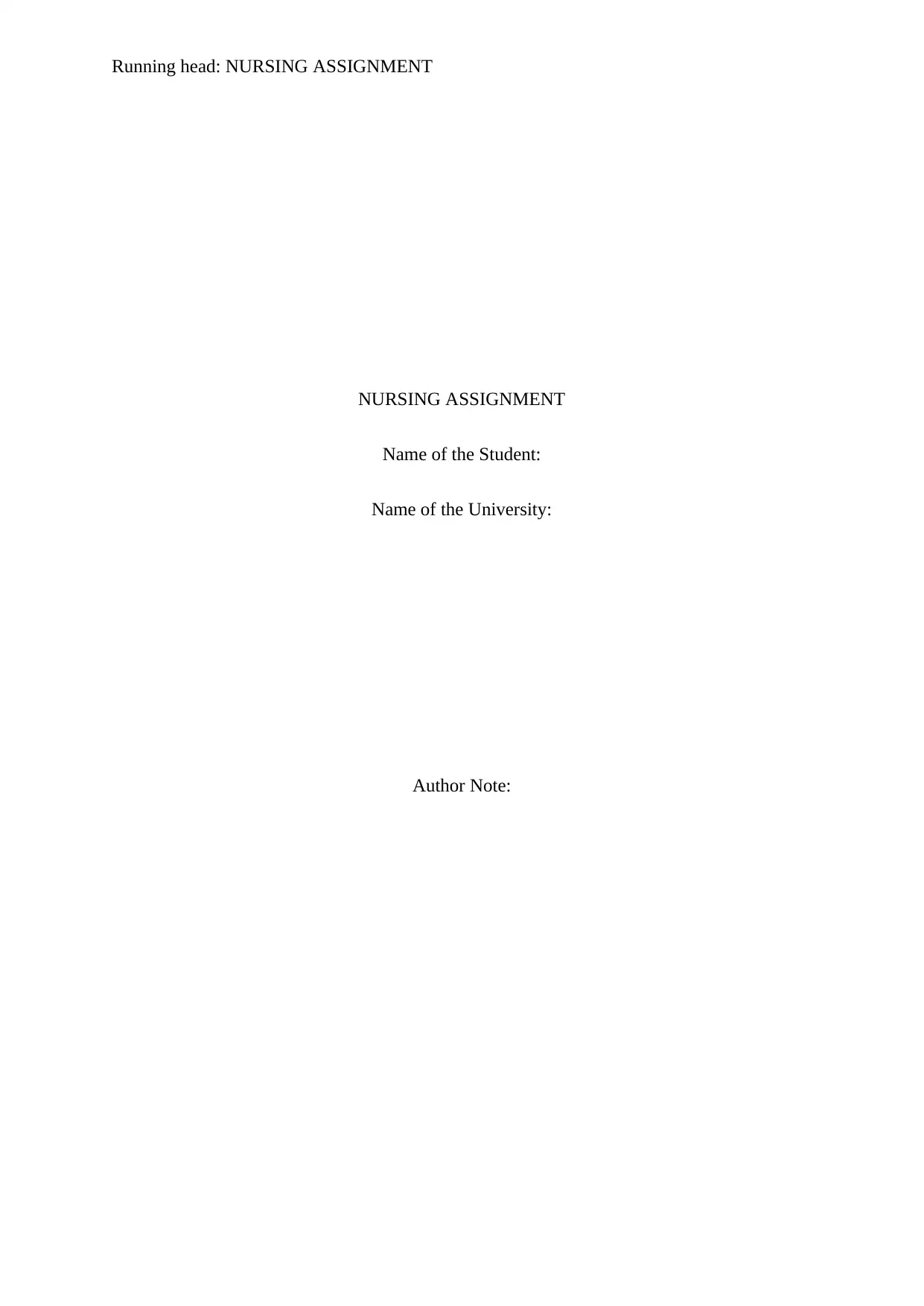
Running head: NURSING ASSIGNMENT
NURSING ASSIGNMENT
Name of the Student:
Name of the University:
Author Note:
NURSING ASSIGNMENT
Name of the Student:
Name of the University:
Author Note:
Paraphrase This Document
Need a fresh take? Get an instant paraphrase of this document with our AI Paraphraser
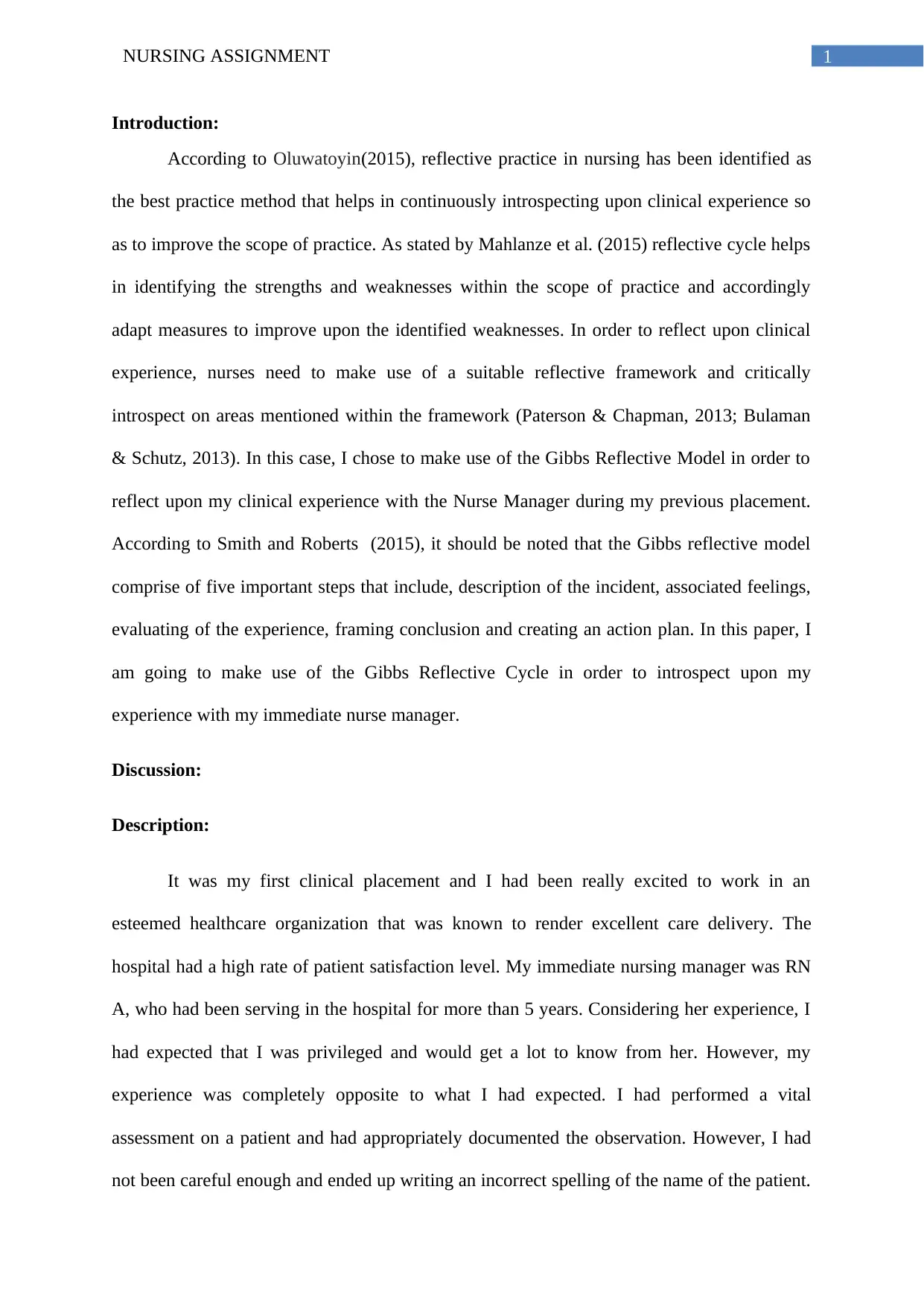
1NURSING ASSIGNMENT
Introduction:
According to Oluwatoyin(2015), reflective practice in nursing has been identified as
the best practice method that helps in continuously introspecting upon clinical experience so
as to improve the scope of practice. As stated by Mahlanze et al. (2015) reflective cycle helps
in identifying the strengths and weaknesses within the scope of practice and accordingly
adapt measures to improve upon the identified weaknesses. In order to reflect upon clinical
experience, nurses need to make use of a suitable reflective framework and critically
introspect on areas mentioned within the framework (Paterson & Chapman, 2013; Bulaman
& Schutz, 2013). In this case, I chose to make use of the Gibbs Reflective Model in order to
reflect upon my clinical experience with the Nurse Manager during my previous placement.
According to Smith and Roberts (2015), it should be noted that the Gibbs reflective model
comprise of five important steps that include, description of the incident, associated feelings,
evaluating of the experience, framing conclusion and creating an action plan. In this paper, I
am going to make use of the Gibbs Reflective Cycle in order to introspect upon my
experience with my immediate nurse manager.
Discussion:
Description:
It was my first clinical placement and I had been really excited to work in an
esteemed healthcare organization that was known to render excellent care delivery. The
hospital had a high rate of patient satisfaction level. My immediate nursing manager was RN
A, who had been serving in the hospital for more than 5 years. Considering her experience, I
had expected that I was privileged and would get a lot to know from her. However, my
experience was completely opposite to what I had expected. I had performed a vital
assessment on a patient and had appropriately documented the observation. However, I had
not been careful enough and ended up writing an incorrect spelling of the name of the patient.
Introduction:
According to Oluwatoyin(2015), reflective practice in nursing has been identified as
the best practice method that helps in continuously introspecting upon clinical experience so
as to improve the scope of practice. As stated by Mahlanze et al. (2015) reflective cycle helps
in identifying the strengths and weaknesses within the scope of practice and accordingly
adapt measures to improve upon the identified weaknesses. In order to reflect upon clinical
experience, nurses need to make use of a suitable reflective framework and critically
introspect on areas mentioned within the framework (Paterson & Chapman, 2013; Bulaman
& Schutz, 2013). In this case, I chose to make use of the Gibbs Reflective Model in order to
reflect upon my clinical experience with the Nurse Manager during my previous placement.
According to Smith and Roberts (2015), it should be noted that the Gibbs reflective model
comprise of five important steps that include, description of the incident, associated feelings,
evaluating of the experience, framing conclusion and creating an action plan. In this paper, I
am going to make use of the Gibbs Reflective Cycle in order to introspect upon my
experience with my immediate nurse manager.
Discussion:
Description:
It was my first clinical placement and I had been really excited to work in an
esteemed healthcare organization that was known to render excellent care delivery. The
hospital had a high rate of patient satisfaction level. My immediate nursing manager was RN
A, who had been serving in the hospital for more than 5 years. Considering her experience, I
had expected that I was privileged and would get a lot to know from her. However, my
experience was completely opposite to what I had expected. I had performed a vital
assessment on a patient and had appropriately documented the observation. However, I had
not been careful enough and ended up writing an incorrect spelling of the name of the patient.
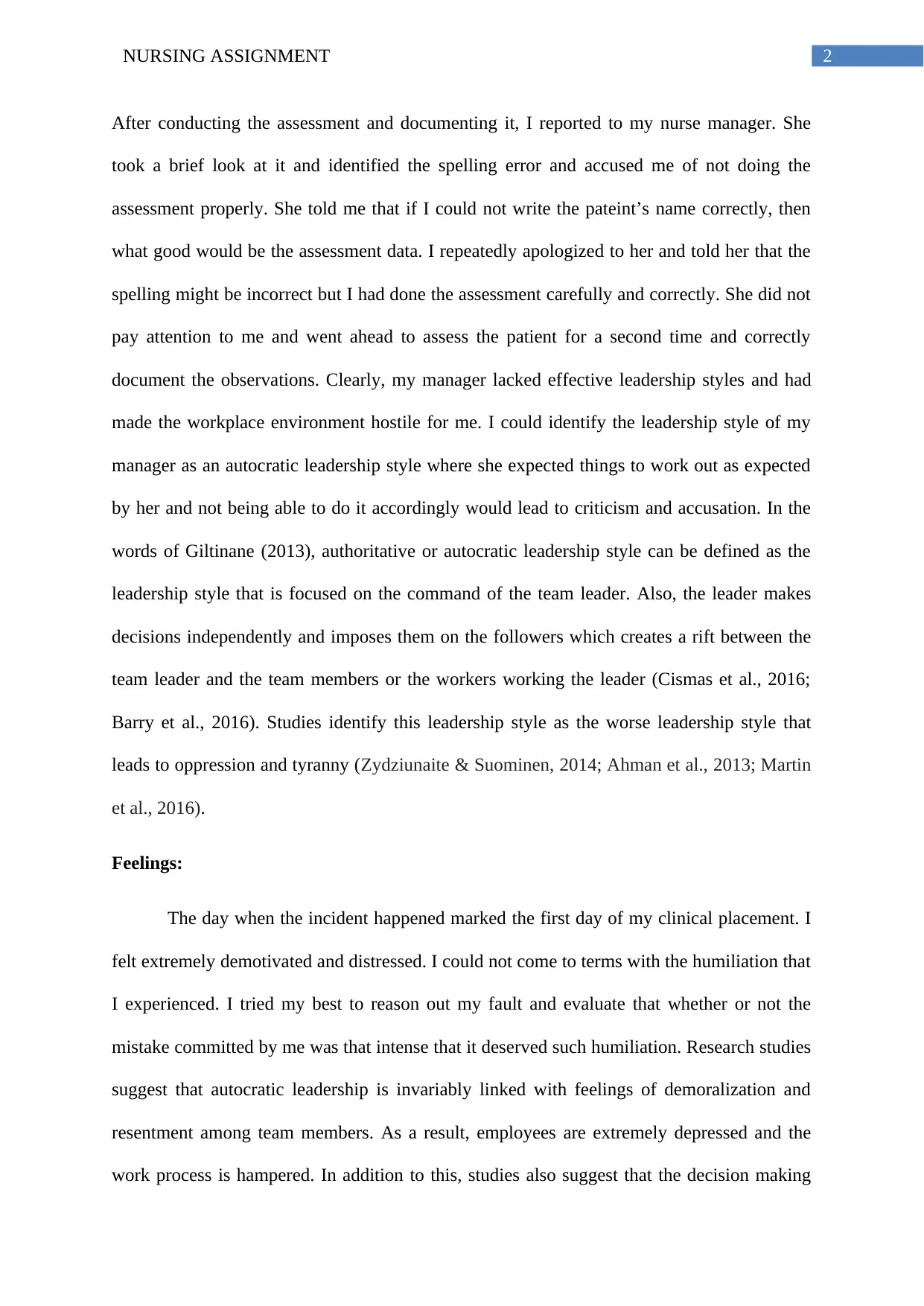
2NURSING ASSIGNMENT
After conducting the assessment and documenting it, I reported to my nurse manager. She
took a brief look at it and identified the spelling error and accused me of not doing the
assessment properly. She told me that if I could not write the pateint’s name correctly, then
what good would be the assessment data. I repeatedly apologized to her and told her that the
spelling might be incorrect but I had done the assessment carefully and correctly. She did not
pay attention to me and went ahead to assess the patient for a second time and correctly
document the observations. Clearly, my manager lacked effective leadership styles and had
made the workplace environment hostile for me. I could identify the leadership style of my
manager as an autocratic leadership style where she expected things to work out as expected
by her and not being able to do it accordingly would lead to criticism and accusation. In the
words of Giltinane (2013), authoritative or autocratic leadership style can be defined as the
leadership style that is focused on the command of the team leader. Also, the leader makes
decisions independently and imposes them on the followers which creates a rift between the
team leader and the team members or the workers working the leader (Cismas et al., 2016;
Barry et al., 2016). Studies identify this leadership style as the worse leadership style that
leads to oppression and tyranny (Zydziunaite & Suominen, 2014; Ahman et al., 2013; Martin
et al., 2016).
Feelings:
The day when the incident happened marked the first day of my clinical placement. I
felt extremely demotivated and distressed. I could not come to terms with the humiliation that
I experienced. I tried my best to reason out my fault and evaluate that whether or not the
mistake committed by me was that intense that it deserved such humiliation. Research studies
suggest that autocratic leadership is invariably linked with feelings of demoralization and
resentment among team members. As a result, employees are extremely depressed and the
work process is hampered. In addition to this, studies also suggest that the decision making
After conducting the assessment and documenting it, I reported to my nurse manager. She
took a brief look at it and identified the spelling error and accused me of not doing the
assessment properly. She told me that if I could not write the pateint’s name correctly, then
what good would be the assessment data. I repeatedly apologized to her and told her that the
spelling might be incorrect but I had done the assessment carefully and correctly. She did not
pay attention to me and went ahead to assess the patient for a second time and correctly
document the observations. Clearly, my manager lacked effective leadership styles and had
made the workplace environment hostile for me. I could identify the leadership style of my
manager as an autocratic leadership style where she expected things to work out as expected
by her and not being able to do it accordingly would lead to criticism and accusation. In the
words of Giltinane (2013), authoritative or autocratic leadership style can be defined as the
leadership style that is focused on the command of the team leader. Also, the leader makes
decisions independently and imposes them on the followers which creates a rift between the
team leader and the team members or the workers working the leader (Cismas et al., 2016;
Barry et al., 2016). Studies identify this leadership style as the worse leadership style that
leads to oppression and tyranny (Zydziunaite & Suominen, 2014; Ahman et al., 2013; Martin
et al., 2016).
Feelings:
The day when the incident happened marked the first day of my clinical placement. I
felt extremely demotivated and distressed. I could not come to terms with the humiliation that
I experienced. I tried my best to reason out my fault and evaluate that whether or not the
mistake committed by me was that intense that it deserved such humiliation. Research studies
suggest that autocratic leadership is invariably linked with feelings of demoralization and
resentment among team members. As a result, employees are extremely depressed and the
work process is hampered. In addition to this, studies also suggest that the decision making
⊘ This is a preview!⊘
Do you want full access?
Subscribe today to unlock all pages.

Trusted by 1+ million students worldwide
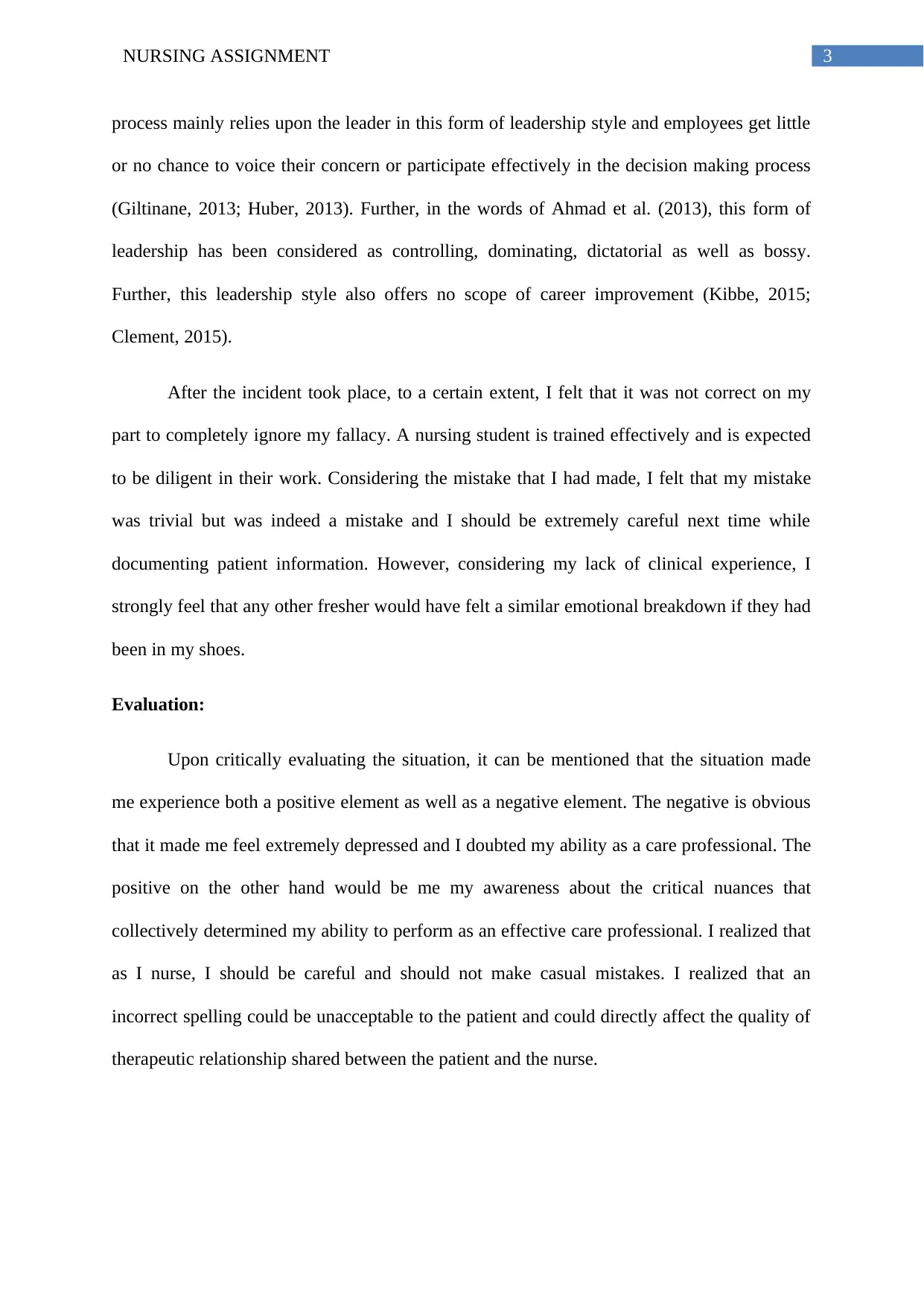
3NURSING ASSIGNMENT
process mainly relies upon the leader in this form of leadership style and employees get little
or no chance to voice their concern or participate effectively in the decision making process
(Giltinane, 2013; Huber, 2013). Further, in the words of Ahmad et al. (2013), this form of
leadership has been considered as controlling, dominating, dictatorial as well as bossy.
Further, this leadership style also offers no scope of career improvement (Kibbe, 2015;
Clement, 2015).
After the incident took place, to a certain extent, I felt that it was not correct on my
part to completely ignore my fallacy. A nursing student is trained effectively and is expected
to be diligent in their work. Considering the mistake that I had made, I felt that my mistake
was trivial but was indeed a mistake and I should be extremely careful next time while
documenting patient information. However, considering my lack of clinical experience, I
strongly feel that any other fresher would have felt a similar emotional breakdown if they had
been in my shoes.
Evaluation:
Upon critically evaluating the situation, it can be mentioned that the situation made
me experience both a positive element as well as a negative element. The negative is obvious
that it made me feel extremely depressed and I doubted my ability as a care professional. The
positive on the other hand would be me my awareness about the critical nuances that
collectively determined my ability to perform as an effective care professional. I realized that
as I nurse, I should be careful and should not make casual mistakes. I realized that an
incorrect spelling could be unacceptable to the patient and could directly affect the quality of
therapeutic relationship shared between the patient and the nurse.
process mainly relies upon the leader in this form of leadership style and employees get little
or no chance to voice their concern or participate effectively in the decision making process
(Giltinane, 2013; Huber, 2013). Further, in the words of Ahmad et al. (2013), this form of
leadership has been considered as controlling, dominating, dictatorial as well as bossy.
Further, this leadership style also offers no scope of career improvement (Kibbe, 2015;
Clement, 2015).
After the incident took place, to a certain extent, I felt that it was not correct on my
part to completely ignore my fallacy. A nursing student is trained effectively and is expected
to be diligent in their work. Considering the mistake that I had made, I felt that my mistake
was trivial but was indeed a mistake and I should be extremely careful next time while
documenting patient information. However, considering my lack of clinical experience, I
strongly feel that any other fresher would have felt a similar emotional breakdown if they had
been in my shoes.
Evaluation:
Upon critically evaluating the situation, it can be mentioned that the situation made
me experience both a positive element as well as a negative element. The negative is obvious
that it made me feel extremely depressed and I doubted my ability as a care professional. The
positive on the other hand would be me my awareness about the critical nuances that
collectively determined my ability to perform as an effective care professional. I realized that
as I nurse, I should be careful and should not make casual mistakes. I realized that an
incorrect spelling could be unacceptable to the patient and could directly affect the quality of
therapeutic relationship shared between the patient and the nurse.
Paraphrase This Document
Need a fresh take? Get an instant paraphrase of this document with our AI Paraphraser

4NURSING ASSIGNMENT
Analysis:
Upon closely analyzing the situation, I realized that a wide communication gap
between me and my manager had triggered the strenuous situation. Further, I feel that I could
have consulted or talked about the matter with other RNs working there. This would have
helped me in knowing about their experiences with the supervisors. Also, it would have
clarified my perception about the supervisor. Their feedback would have mattered as they
would have told me about the leadership style and the trait of the leader and on previously
knowing the behavioural trait and leadership style of the supervisor, I would have been more
careful and would also not have felt so demoralized.
Conclusion:
Therefore, to conclude, I feel that the situation that I experienced, could be
experienced by other nurses. There was a primary need to point out the fallacy with the work
process and the leadership style adapted by the manager. I believe I could have tried to
communicate with the supervisor instead of being scared and distressed. I could have even
talked to the Human Resource Manager and mentioned about my poor clinical experience.
This would have greatly helped as the Human Resource Manager would then have
communicated with the leader and could have solved the strenuous situation. However, I was
unable to apply any of the strategies mentioned above on account of fear and distress.
Therefore, I feel that I need to work on myself and improve my communication skills so that
I am able to share the issue with the concerned authority. Further, I also feel that I need to be
more careful while conducting and documenting patient assessments so as to avoid any trivial
error. In addition to this, I feel that I should also read more about different leadership style
and learn about the organizational procedure of reporting a case of unjustified accusation so
that in future, I do not have to be depressed or go through an emotional turmoil.
Analysis:
Upon closely analyzing the situation, I realized that a wide communication gap
between me and my manager had triggered the strenuous situation. Further, I feel that I could
have consulted or talked about the matter with other RNs working there. This would have
helped me in knowing about their experiences with the supervisors. Also, it would have
clarified my perception about the supervisor. Their feedback would have mattered as they
would have told me about the leadership style and the trait of the leader and on previously
knowing the behavioural trait and leadership style of the supervisor, I would have been more
careful and would also not have felt so demoralized.
Conclusion:
Therefore, to conclude, I feel that the situation that I experienced, could be
experienced by other nurses. There was a primary need to point out the fallacy with the work
process and the leadership style adapted by the manager. I believe I could have tried to
communicate with the supervisor instead of being scared and distressed. I could have even
talked to the Human Resource Manager and mentioned about my poor clinical experience.
This would have greatly helped as the Human Resource Manager would then have
communicated with the leader and could have solved the strenuous situation. However, I was
unable to apply any of the strategies mentioned above on account of fear and distress.
Therefore, I feel that I need to work on myself and improve my communication skills so that
I am able to share the issue with the concerned authority. Further, I also feel that I need to be
more careful while conducting and documenting patient assessments so as to avoid any trivial
error. In addition to this, I feel that I should also read more about different leadership style
and learn about the organizational procedure of reporting a case of unjustified accusation so
that in future, I do not have to be depressed or go through an emotional turmoil.

5NURSING ASSIGNMENT
Action plan:
Therefore, on the basis of the reflection, I have clearly identified two clinical areas
where I need to improve so that I am able to care effectively and practice confidently within a
healthcare setting. The two identified areas comprised of ineffective knowledge about
leadership style and organizational procedure of reporting a harassment. The second area
would comprise of the ability to communicate effectively in order to share a concern. In
addition to this, I also realized that I needed to have a clear understanding about the
professional standard of practice and the NSQHS standards that clearly mention the standards
of effective patient care provision to patients. Therefore, in order to know more about the
leadership styles and the organizational procedure of reporting, I would browse online
resources on effective leadership and management prevalent within the healthcare sector. In
addition to this, I would also browse through the internet to know more about the procedure
of reporting that should be followed while raising concern about a harassment. In addition to
this, I would work on my communication skills so that I am able to communicate effectively
with my supervisors in future. This would boost my confidence level and would also promote
clarity in communication flow. In order to work on my communication skills, I would attend
workshops on effective communication and building a positive therapeutic relationship. In
addition to this, I would also browse online materials about effective communication that
would help me in working on my skills.
Conclusion:
Therefore, to conclude it can be mentioned that while working in a clinical
environment, there are a number of stressors and facilitators that are encountered. The
stressors refer to the negative experiences such as bullying, harassment or ineffective
leadership style. The facilitators on the other hand refer to the positive experience. The
Action plan:
Therefore, on the basis of the reflection, I have clearly identified two clinical areas
where I need to improve so that I am able to care effectively and practice confidently within a
healthcare setting. The two identified areas comprised of ineffective knowledge about
leadership style and organizational procedure of reporting a harassment. The second area
would comprise of the ability to communicate effectively in order to share a concern. In
addition to this, I also realized that I needed to have a clear understanding about the
professional standard of practice and the NSQHS standards that clearly mention the standards
of effective patient care provision to patients. Therefore, in order to know more about the
leadership styles and the organizational procedure of reporting, I would browse online
resources on effective leadership and management prevalent within the healthcare sector. In
addition to this, I would also browse through the internet to know more about the procedure
of reporting that should be followed while raising concern about a harassment. In addition to
this, I would work on my communication skills so that I am able to communicate effectively
with my supervisors in future. This would boost my confidence level and would also promote
clarity in communication flow. In order to work on my communication skills, I would attend
workshops on effective communication and building a positive therapeutic relationship. In
addition to this, I would also browse online materials about effective communication that
would help me in working on my skills.
Conclusion:
Therefore, to conclude it can be mentioned that while working in a clinical
environment, there are a number of stressors and facilitators that are encountered. The
stressors refer to the negative experiences such as bullying, harassment or ineffective
leadership style. The facilitators on the other hand refer to the positive experience. The
⊘ This is a preview!⊘
Do you want full access?
Subscribe today to unlock all pages.

Trusted by 1+ million students worldwide
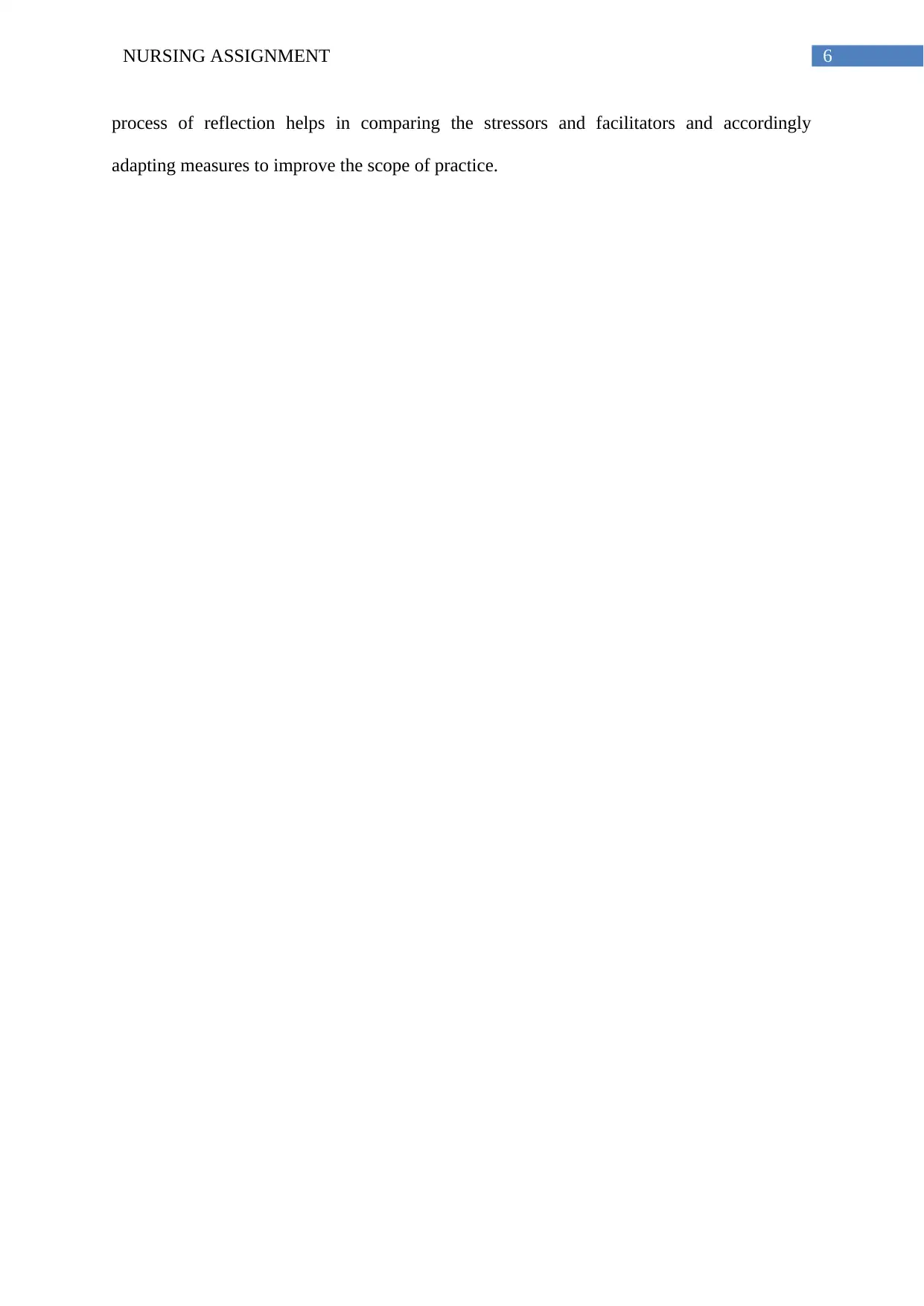
6NURSING ASSIGNMENT
process of reflection helps in comparing the stressors and facilitators and accordingly
adapting measures to improve the scope of practice.
process of reflection helps in comparing the stressors and facilitators and accordingly
adapting measures to improve the scope of practice.
Paraphrase This Document
Need a fresh take? Get an instant paraphrase of this document with our AI Paraphraser
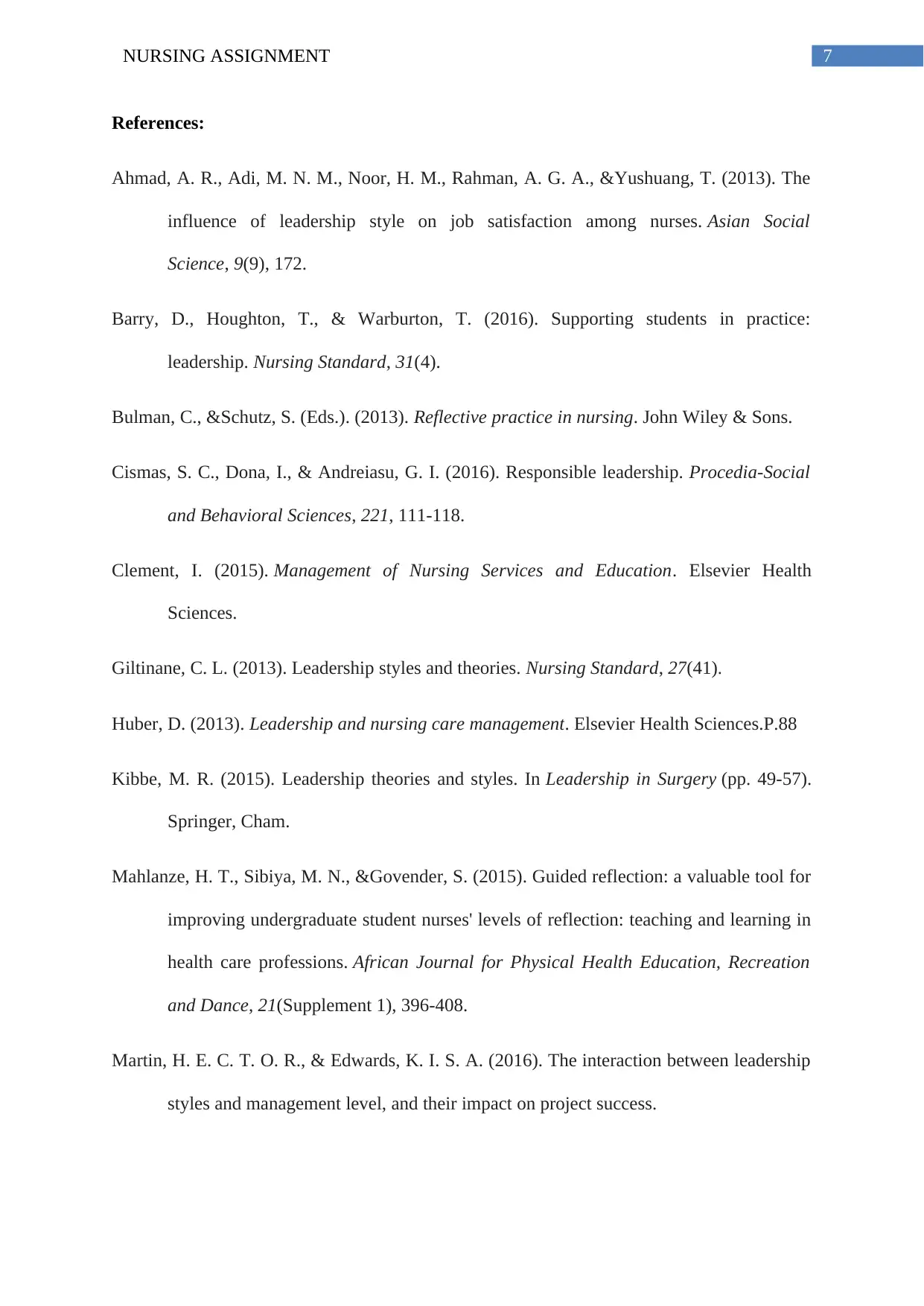
7NURSING ASSIGNMENT
References:
Ahmad, A. R., Adi, M. N. M., Noor, H. M., Rahman, A. G. A., &Yushuang, T. (2013). The
influence of leadership style on job satisfaction among nurses. Asian Social
Science, 9(9), 172.
Barry, D., Houghton, T., & Warburton, T. (2016). Supporting students in practice:
leadership. Nursing Standard, 31(4).
Bulman, C., &Schutz, S. (Eds.). (2013). Reflective practice in nursing. John Wiley & Sons.
Cismas, S. C., Dona, I., & Andreiasu, G. I. (2016). Responsible leadership. Procedia-Social
and Behavioral Sciences, 221, 111-118.
Clement, I. (2015). Management of Nursing Services and Education. Elsevier Health
Sciences.
Giltinane, C. L. (2013). Leadership styles and theories. Nursing Standard, 27(41).
Huber, D. (2013). Leadership and nursing care management. Elsevier Health Sciences.P.88
Kibbe, M. R. (2015). Leadership theories and styles. In Leadership in Surgery (pp. 49-57).
Springer, Cham.
Mahlanze, H. T., Sibiya, M. N., &Govender, S. (2015). Guided reflection: a valuable tool for
improving undergraduate student nurses' levels of reflection: teaching and learning in
health care professions. African Journal for Physical Health Education, Recreation
and Dance, 21(Supplement 1), 396-408.
Martin, H. E. C. T. O. R., & Edwards, K. I. S. A. (2016). The interaction between leadership
styles and management level, and their impact on project success.
References:
Ahmad, A. R., Adi, M. N. M., Noor, H. M., Rahman, A. G. A., &Yushuang, T. (2013). The
influence of leadership style on job satisfaction among nurses. Asian Social
Science, 9(9), 172.
Barry, D., Houghton, T., & Warburton, T. (2016). Supporting students in practice:
leadership. Nursing Standard, 31(4).
Bulman, C., &Schutz, S. (Eds.). (2013). Reflective practice in nursing. John Wiley & Sons.
Cismas, S. C., Dona, I., & Andreiasu, G. I. (2016). Responsible leadership. Procedia-Social
and Behavioral Sciences, 221, 111-118.
Clement, I. (2015). Management of Nursing Services and Education. Elsevier Health
Sciences.
Giltinane, C. L. (2013). Leadership styles and theories. Nursing Standard, 27(41).
Huber, D. (2013). Leadership and nursing care management. Elsevier Health Sciences.P.88
Kibbe, M. R. (2015). Leadership theories and styles. In Leadership in Surgery (pp. 49-57).
Springer, Cham.
Mahlanze, H. T., Sibiya, M. N., &Govender, S. (2015). Guided reflection: a valuable tool for
improving undergraduate student nurses' levels of reflection: teaching and learning in
health care professions. African Journal for Physical Health Education, Recreation
and Dance, 21(Supplement 1), 396-408.
Martin, H. E. C. T. O. R., & Edwards, K. I. S. A. (2016). The interaction between leadership
styles and management level, and their impact on project success.
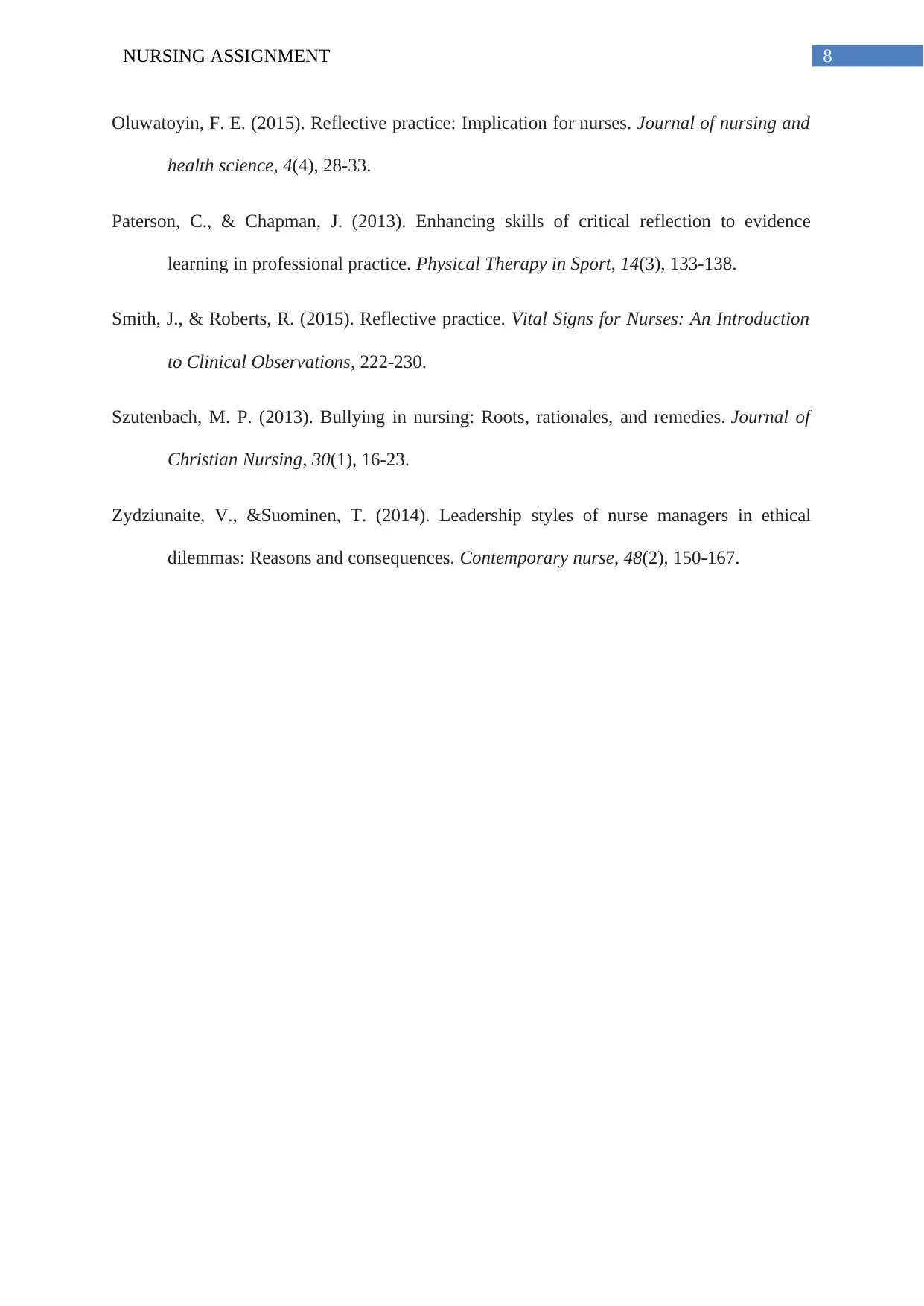
8NURSING ASSIGNMENT
Oluwatoyin, F. E. (2015). Reflective practice: Implication for nurses. Journal of nursing and
health science, 4(4), 28-33.
Paterson, C., & Chapman, J. (2013). Enhancing skills of critical reflection to evidence
learning in professional practice. Physical Therapy in Sport, 14(3), 133-138.
Smith, J., & Roberts, R. (2015). Reflective practice. Vital Signs for Nurses: An Introduction
to Clinical Observations, 222-230.
Szutenbach, M. P. (2013). Bullying in nursing: Roots, rationales, and remedies. Journal of
Christian Nursing, 30(1), 16-23.
Zydziunaite, V., &Suominen, T. (2014). Leadership styles of nurse managers in ethical
dilemmas: Reasons and consequences. Contemporary nurse, 48(2), 150-167.
Oluwatoyin, F. E. (2015). Reflective practice: Implication for nurses. Journal of nursing and
health science, 4(4), 28-33.
Paterson, C., & Chapman, J. (2013). Enhancing skills of critical reflection to evidence
learning in professional practice. Physical Therapy in Sport, 14(3), 133-138.
Smith, J., & Roberts, R. (2015). Reflective practice. Vital Signs for Nurses: An Introduction
to Clinical Observations, 222-230.
Szutenbach, M. P. (2013). Bullying in nursing: Roots, rationales, and remedies. Journal of
Christian Nursing, 30(1), 16-23.
Zydziunaite, V., &Suominen, T. (2014). Leadership styles of nurse managers in ethical
dilemmas: Reasons and consequences. Contemporary nurse, 48(2), 150-167.
⊘ This is a preview!⊘
Do you want full access?
Subscribe today to unlock all pages.

Trusted by 1+ million students worldwide
1 out of 9
Related Documents
Your All-in-One AI-Powered Toolkit for Academic Success.
+13062052269
info@desklib.com
Available 24*7 on WhatsApp / Email
![[object Object]](/_next/static/media/star-bottom.7253800d.svg)
Unlock your academic potential
Copyright © 2020–2025 A2Z Services. All Rights Reserved. Developed and managed by ZUCOL.





